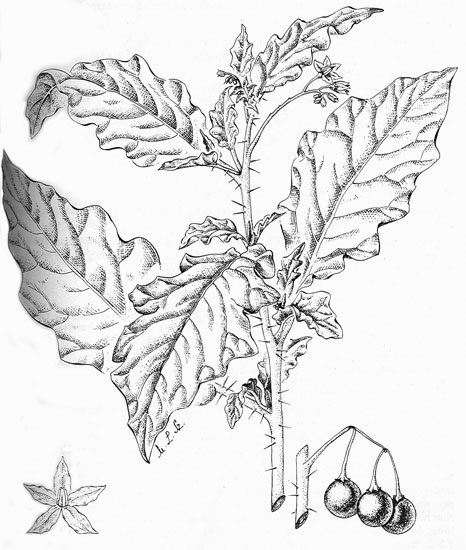 Line drawing by M. Szent Ivany, J. Adelaide Bot. Gard. 4 (1981) 139, fig. 49. |
 Distribution map generated from Australia's Virtual Herbarium. |

Synonymy
Solanum yirrkalense Symon, J. Adelaide Bot. Gard. 4: 137, as 'yirrkalensis'; figs 47, 49 (1981)
T: Yirrkala Gardens, N.T., 27 Feb. 1976, D. Hinz 7633; holo: DNA ex NT; iso: AD ex ADW, BRI, CANB, DNA, K, L, NSW.
Description
Low spreading shrub, dark green, pubescent with minute stellate hairs; hairs dense on lower leaf-surface, sparse to absent on upper surface; prickles absent, or to 5 mm long, scattered on stems and leaf-surfaces.
Leaves elliptic; lamina 5–13 cm long, 2.5–6 cm wide, discolorous, entire or shallowly lobed; petiole 5–22 mm long. Lower leaves broadly elliptic, the lamina up to 12 cm long, 7 cm wide, shallowly lobed; petiole to 3 cm long.
Inflorescence up to 8–flowered [5-35-flowered according to Bean 2004]; lower flowers bisexual, upper flowers male; peduncle 5–20 mm long; rachis up to 10 mm long; pedicels to 20 mm long. Bisexual flowers: calyx 3–6 mm long, the lobes lanceolate, 1–3 mm long; corolla stellate, deeply incised, to 25 mm diam., white or faintly tinged blue; anthers 5 mm long. Male flowers similar: calyx-lobes very short; corolla 10–15 mm diam.
Berry globular, 10–15 mm diam., red. Seeds 4–5 mm long, dark brown or pale yellow, hairy. n=12.
[Bean's (2004) description of S. yirrkalense differs in some respects from that of Symon. He says that there is not a distinctive difference between the male and bisexual flowers, that there are many more flowers per inflorescence, the ovary is glabrous and that the style is glabrous or has stellate hairs only. His description of this species can be found at http://delta-intkey.com/solanum/www/yirrkale.htm]
Distribution and ecology
An inadequately known species, originally recorded only from Yirrkala, N.T., on disturbed edge of vine forest on coastal dune, in red sandy soil. Now also known from similar habitat from the Bamaga region of northern Queensland and by a single C.T.White collection from Bioto in [Papua] New Guinea (Bean 2004).
Relationships
S. yirrkalense is most similar to S. discolor from which it can be distinguished by its
- usually broader leaves, 3.5-6 cm wide (vs 1.6-4.5 cm wide in S. discolor )
- usually longer petioles, 0.5-2.5 cm long (vs to 1 cm long in S. discolor )
- longer common peduncle, 3-12 mm long (vs 0-2 mm long for S. discolor )
Both species are part of the S. ferocissimum group of subgen. Leptostemonum according to Bean (2004) together with S. chenopodinum, S. corifolium, S. defensum, S. discolor, S. dissectum, S. dryanderense, S. dysprosium, S. ferocissimum, S. fervens, S. inaequilaterum, S. latens, S. lythrocarpum, S. mentiens, S. shirleyanum and S. stelligerum .
Notes
Bean (Austrobaileya 6: 688, 2004) corrected the spelling of the epithet from the original 'yirrkalensis' used in the protologue.
Derivation of epithet
Named for the collecting locality of the type specimen.
Selected specimens
N.T.: Yirrkala, N. Scarlett 275 (AD); QLD: Newcastle Bay, 2.5 miles S of Somerset, May 1948, L.Brass 18720 (BRI, CANB).
Plant status, if any
Originally classified as Risk Code 2K (Briggs & Leigh, Rare or Threatened Australian Plants, 1995), but Bean (Austrobaileya 6: 689, 2004) did not consider it to be at risk.
Conservation status as a Data Deficient plant in the
From the web
Further information and links for this species can be found on the Solanaceae Source site.